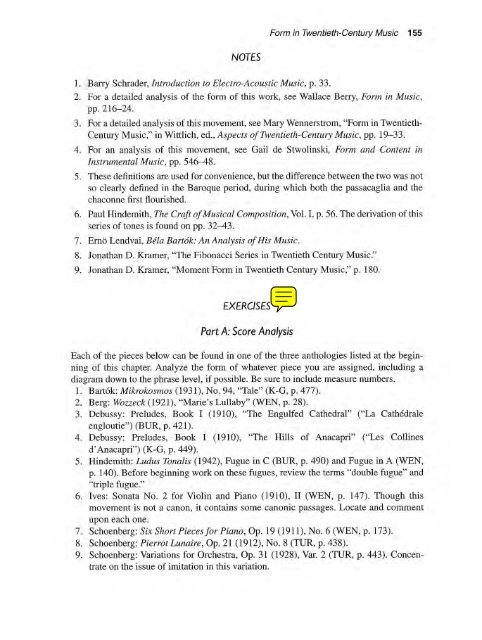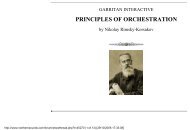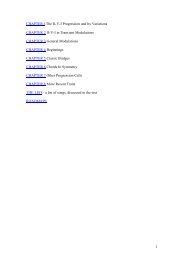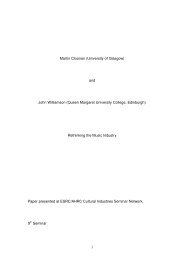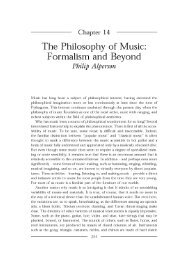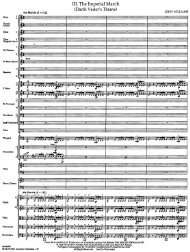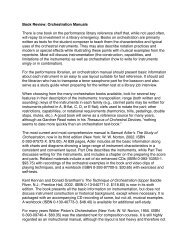TWENTIETH- - Synapse Music
TWENTIETH- - Synapse Music
TWENTIETH- - Synapse Music
You also want an ePaper? Increase the reach of your titles
YUMPU automatically turns print PDFs into web optimized ePapers that Google loves.
NOTES<br />
1. Barry Schrader, Introduction to Electro-Acoustic <strong>Music</strong>, p. 33.<br />
Form in Twentieth-Century <strong>Music</strong> 155<br />
2. For a detailed analysis of the form of this work, see Wallace Berry, Form in <strong>Music</strong>,<br />
pp.216-24.<br />
3. For a detailed analysis of this movement, see Mary Wennerstrom, "Form in Twentieth<br />
Century <strong>Music</strong>," in Wittlich, ed., Aspects afTwentieth-Century <strong>Music</strong>, pp. 19-33.<br />
4. For an analysis of this movement, see Gail de Stwolinski, Form and Content in<br />
Instrumental <strong>Music</strong>, pp. 546-48.<br />
5. These definitions are used for convenience, but the difference between the two was not<br />
so clearly defined in the Baroque period, during which both the passacaglia and the<br />
chaconne first flourished.<br />
6. Paul Hindemith, The Craft of <strong>Music</strong>al Composition, Vol. I, p. 56. The derivation of this<br />
series of tones is found on pp. 32-43.<br />
7. Erna Lendvai, Bila Bartok: An Analysis of His <strong>Music</strong>.<br />
8. Jonathan D. Kramer, 'The Fibonacci Series in Twentieth Century <strong>Music</strong>."<br />
9. Jonathan D. Kramer, "Moment Form in Twentieth Century <strong>Music</strong>," p. 180.<br />
EXERCISES<br />
Part A: Score Analysis<br />
Each of the pieces below can be found in one of the three anthologies listed at the beginning<br />
of this chapter. Analyze the form of whatever piece you are assigned, including a<br />
diagram down to the phrase level, if possible. Be sure to include measure numbers.<br />
I. Bartok: Mikrokosmos (1931), No. 94, "Tale" (K-G, p. 477).<br />
2. Berg: Wozzeck (1921), "Marie's Lullaby" (WEN, p. 28).<br />
3. Debussy: Preludes, Book I (1910), "The Engulfed Cathedral" ("La Cathedrale<br />
engloutie") (BUR, p. 421).<br />
4. Debussy: Preludes, Book I (1910), "The Hills of Anacapri" ("Les Collines<br />
d' Anacapri") (K-G, p. 449).<br />
5. Hindcmith: Ludus TOllalis (1942), Fugue in C (BUR, p. 490) and Fugue in A (WEN,<br />
p. 140). Before beginning work on these fugues, review the terms "double fugue" and<br />
"triple fugue."<br />
6. Ives: Sonata No.2 for Violin and Piano (1910), II (WEN, p. 147). Though this<br />
movement is not a canon, it contains some canonic passages. Locate and comment<br />
upon each one.<br />
7. Schoenberg: Six Short Pieces for Piano, Op. 19 (1911), No.6 (WEN, p. 173).<br />
8. Schoenberg: Pierrot Lunaire, Op. 21 (1912), No.8 (TUR, p. 438).<br />
9. Schoenberg: Variations for Orchestra, Op. 31 (1928), Var. 2 (TUR, p. 443). Concentrate<br />
on the issue of imitation in this variation.


